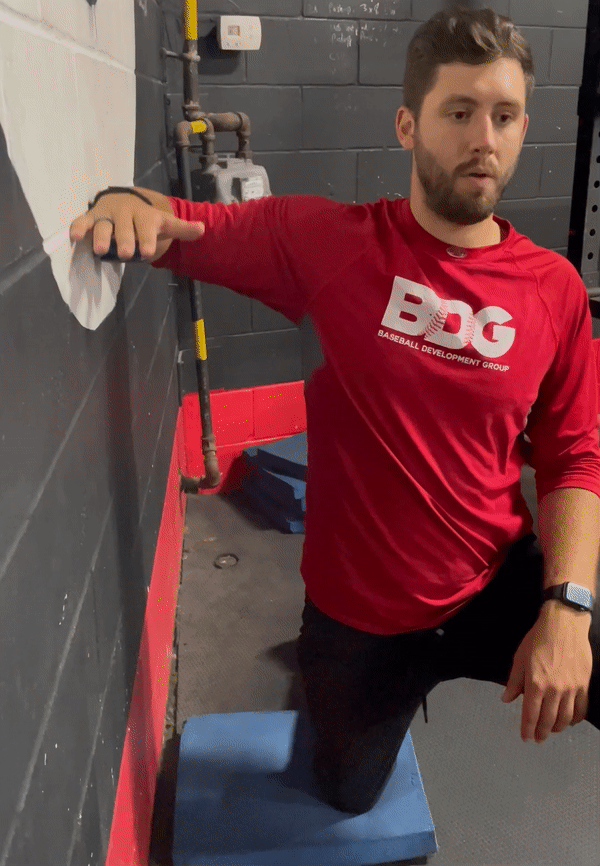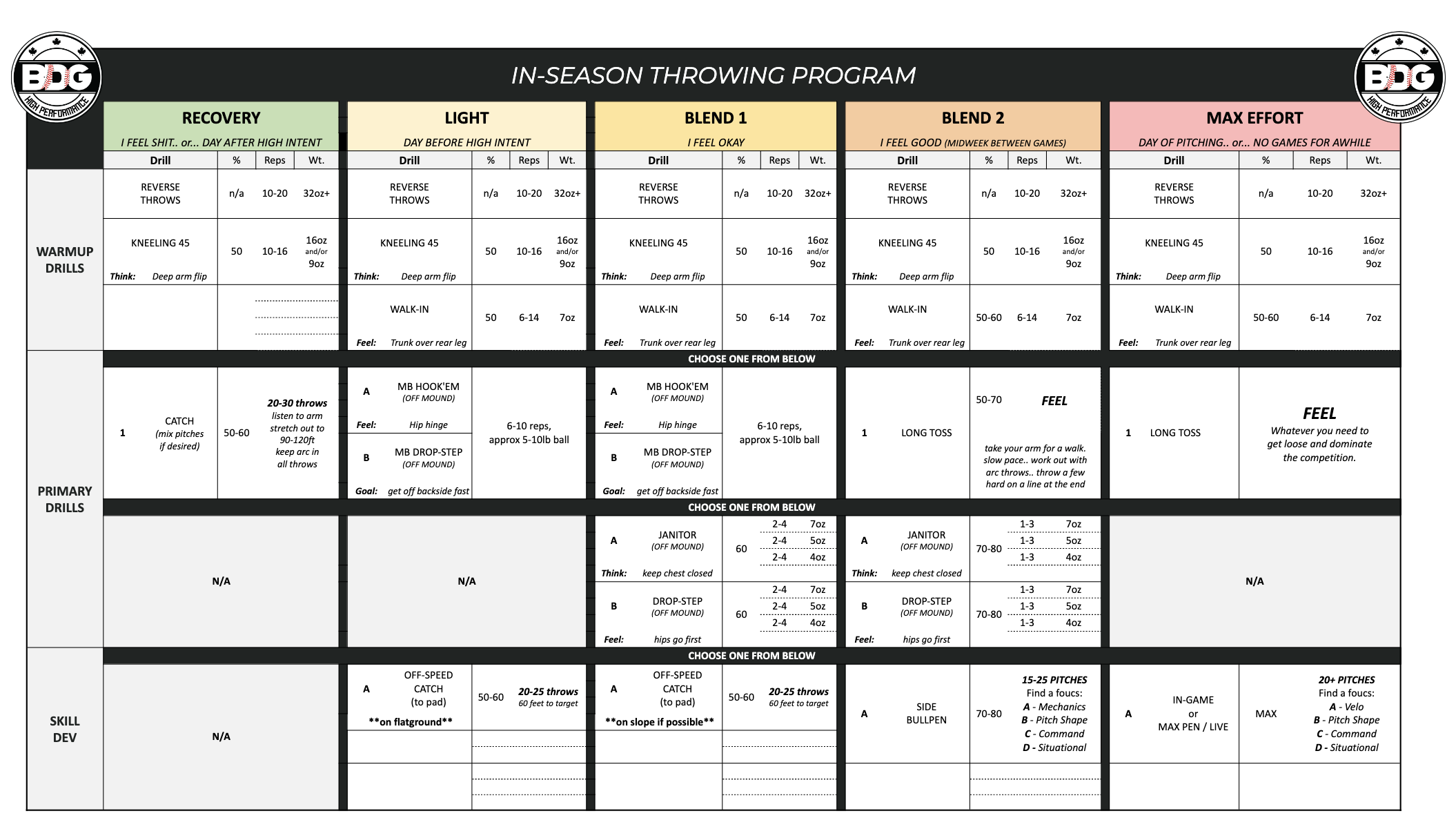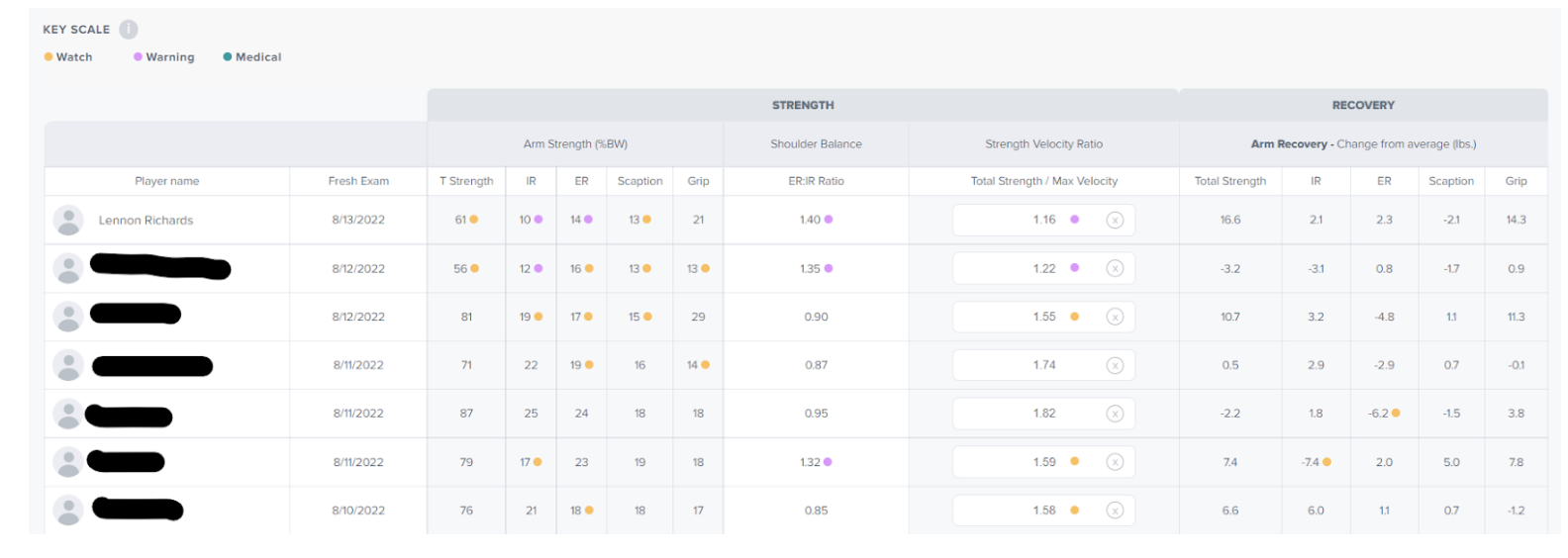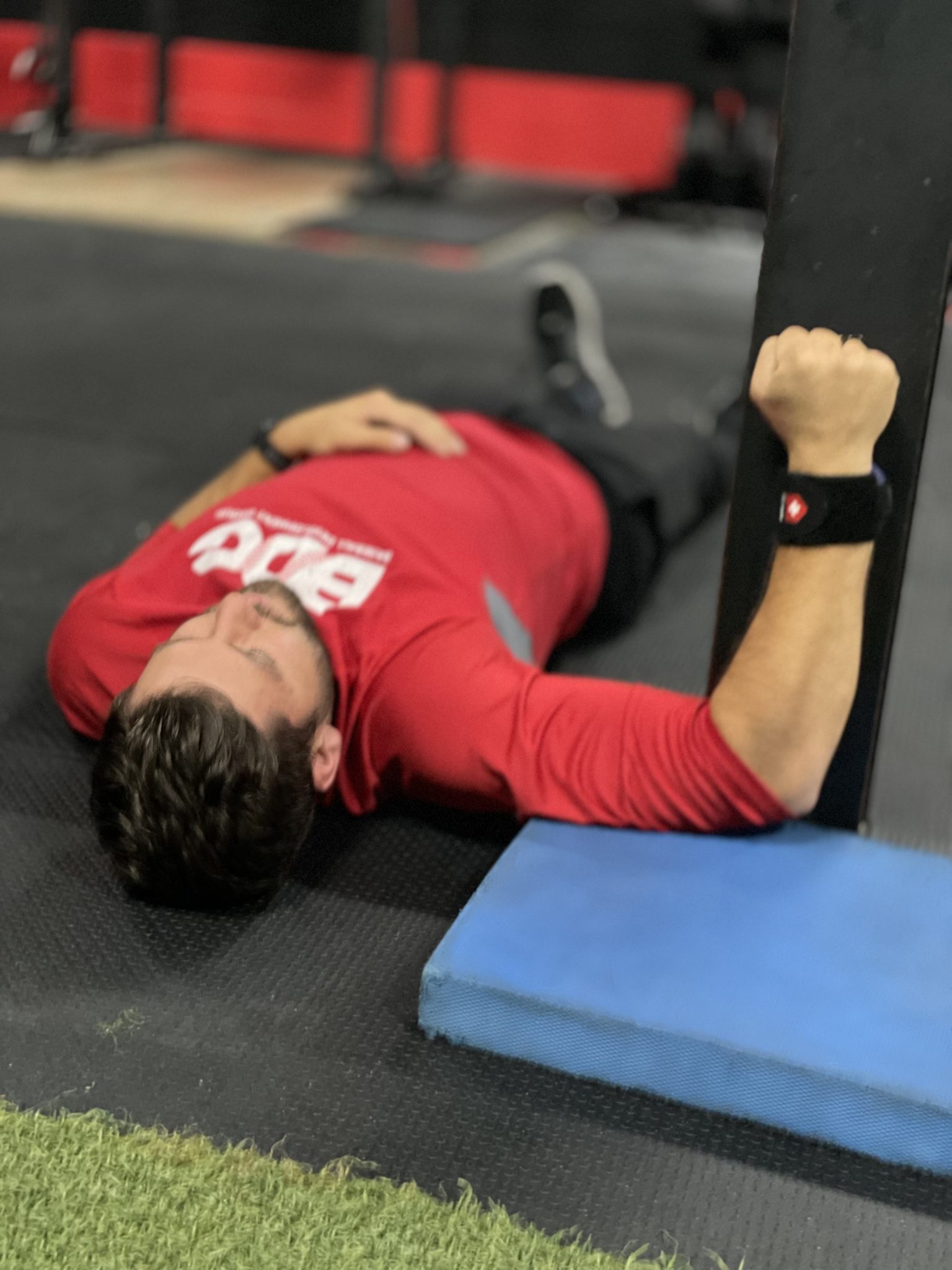ArmCare.com First Impressions: A Data-led Approach to Arm Health
by Dr. Tyler Dobos & Lennon Richards | Aug 23rd, 2022
Introduction
A few weeks ago the BDG team finally got our hands on the new ArmCare.com ActivForce device (their two-in-one dynamometer (measures force) and digital goniometer (measures ROM)) and associated app. We’ve spent that time onboarding ourselves and our players, collecting as much data as possible, and attempting to uncover the best possible strategies for integration within the flow of our athletes’ daily training.
This blog post is going to try and detail our experience over that time, and will hopefully save you some time and effort if/when you decide to pull the trigger and upgrade your current strength/ROM monitoring process.
First, some disclaimers:
- Opinions, current usage, and strategies are obviously fresh and likely to change in upcoming months. Goal is to periodically update everyone in succession. Call this V1 of many.
- We haven’t spent nearly enough time using the app yet to make any hard comments about player health, velocity enhancement, etc., despite how promising early results have been. The law of small numbers = acknowledged.
- Big shout out to Garrett Boyum for his take on the product. Appreciate you, man.
Now that that’s out of the way, here’s what we’ll cover in this post:
- Our current “exam” schedule
- Recovery/ response programming tactics
- Collaborative potential
BDG’s Current Exam Schedule
The platform comes with several different exam options. A pre-throwing “fresh exam” that includes bilateral ROM and strength testing, a pre-throwing “quick exam” that measures throwing arm ROM and strength, and a post-throwing “post exam” that measures the same metrics as the quick exam. An “arm primer” and “strength test” subsections are also available.
There is a bit of a learning curve. I suggest running yourself through the protocol for a few sessions before you start onboarding players. I also suggest holding the phone they are using for their first trial run, and really helping them through the ROM part of the assessment (so they don’t compensate).
The first session will require you to perform some upper limb measurements, and teach your athletes adequate positioning and setup for testing. I will say that after walking an athlete through the full fresh exam one time, the athletes are generally proficient in all of the testing and measurements they will be exposed to. Still, I would recommend having a coach present for all ROM testing regardless of how many assessments they’ve done.

Figure 1: Example of an athlete “cheating” their active range of motion tests.
Now to our exam schedule.
Arm Primer – Every day except Recovery
Full Fresh Exam – 1x/month
Quick Exam – Every Blend 2/ Max Effort
Quick Exam *Skip the ROM* – Blend 1/ Light
Post Exam – Any day you do pre-testing. Skip ROM if you skipped it earlier
In order to fully appreciate how we’re collecting our data, a quick refresher on our in-season throwing schedule is needed, since we are pairing different test protocols on different throwing days.

Figure 2: Example of an in-season throwing program for our High School athletes.
As you can see, there is a progression in intensity from left to right, moving from a recovery day through to a max effort day. We’ve assigned a different set of tests to each throwing day, to capture the information we believe to be the most pertinent and influential in our approach.
Recovery
No usage.
These days vary from player to player, but the general idea is that you’re supposed to be recovering. All of the arm priming and strength measurements require multiple iterations of max effort (ME) isometric contractions. Considering the goals for the day, anything ME seems like a poor strategy to adopt. As such, these days are *currently* the only days the app/product is left alone. Though, once players are back on a regular fall schedule our priorities are going to shift from data collection to a more standardized collection protocol. It’s unlikely recovery days are going to change.
Blend 1 / Light
These days are geared towards maintaining chronic workload, and just getting your work in. We feature the arm primer here at the end of our dynamic warm-up, and then move through a quick exam, but skip the ROM section. After throwing, a post exam is performed, with the ROM section again skipped. Volume and intensity are pretty low on these days, and so currently, we don’t assign much value to any ROM changes that may be present (though we don’t expect anything to change).
We are likely going to remove all testing pre and post from this day once the fall/ offseason starts. As mentioned above, we just want *ALL* the data we can right now. Overkill? Maybe. However, the more informed we are for the offseason the better.
Long term, we view this as an opportunity to further investigate guys while they’re still in-season. Are we able to profile players into different buckets? Do some people recover faster than others? Could that bias guys towards being a reliever or starter? How does intra-week recovery affect arm scores? Is there such a thing as too much data for a player?
We are going to find out.
Blend 2 / Max Effort
(Minimum 1x a week in a standard throwing program)
Depending on where your games line up, the current throwing schedule you’re on, or where in your season you are, the frequency with which higher effort throwing occurs can be all over the place for some, or perfectly consistent for others. Either way, most athletes in-season fall somewhere between 1-3 of these higher effort sessions per week. On these days, we have been using the arm primer at the end of the dynamic, followed by the full quick exam (ROM and strength). After throwing, a full post exam (ROM and strength) are tested.
Max Effort
(1x a month)
Once a month on one of your max effort days, we are planning on performing a full fresh exam after the arm primer. The major difference between a fresh exam and a quick exam is that the fresh exam also measures your non-dominant arm in ROM and strength.
It doesn’t take that much more time once you have the protocols down, but we just don’t see much utility in testing that range any more frequently than 1x/ month (at the most). After throwing, a full post exam is performed.
There are a few reasons we feel this way about the 1x/month full fresh exam, the biggest of which is that we consistently assess active ROM with our daily CARs check-ins. Whenever a coach or player notes some variance from their normal, we tend to throw them on the table and check things out further. Our general assumption is that with consistent mobility work targeting both sides of the body, the non-throwing side ROM shouldn’t change that much throughout a development plan.
Throwing arm ROM we do expect to change over time, though we expect changes to be gradual and only apparent after enough time has passed from test to test. We think it unlikely that a daily/weekly test would be sensitive enough to elicit changes in this regard, barring injury.
Like I stated above, we are in data collection mode. We are probably being overzealous and collecting too much. However, the app lets you “hide” exams, which removes them from subsequent analysis. That means I can collect an insane amount of data and then hide the meaningless/ less meaningful stuff whenever I finally get around to analysis
Recovery Response Programming Tactics
In the past, we’ve spent the majority of our tertiary “D” block training ‘accessory’ lifts such as shoulder rotation, scapular work, grip strength, core based work, or specialty exercises. We generally cycle through different iterations of these exercises, in a one-after-the-other fashion (depending on the time of year and earlier exercises – i.e., heavy deadlift/pullup day would likely not feature grip based work as their final lift). Whenever complaints arise (soreness, stiffness, obvious weakness noticed), this section is what we typically manipulate to best accommodate uniqueness.
The biggest issue is that it was reactionary rather than preemptive. By the time we noticed something, it was often too late.
We first attempted to improve this process through testing isometric shoulder strength pre-throwing with our athletes, to gauge relative shoulder preparedness around Christmas 2021. Athlete isometric shoulder ER, IR (both with 0° abduction), and scaption strength were assessed. Our goal was to use these data to program appropriate recovery/ tertiary lifting, and to adjust someone’s throwing on the fly if their shoulder scores were down.
We had moderate success at best.
A longer comparison will be made in the future, but I want to keep this brief. In short, ArmCare has absolutely blown us away, and the amount of data this thing spits out is ridiculous (see figure below).
Oh yeah, and you can download CSVs for each athlete or your team as a whole for heavy data analysis.
We haven’t really dove into the ROM testing much yet, mostly because I’m able to assess range on table and because we’ve only been collecting data for such a short period of time. Though, I think the ROM changes will reveal their insight across a full offseason or rehab protocol – especially if your program doesn’t have someone licensed to measure ROM on a semi-consistent basis.

Figure 3: Screenshot of the Armcare.com Dashboard. PS: please take it easy on Lennon, what he lacks in shoulder strength he more than makes up for with stellar character and excellent graphic design skills
The ActivForce sensor measures ER, IR, and scaption supine, and grip in a half-kneeling stance with the arm at ‘90-90’, and then transforms that data into different metrics and measurables.
As Dr. Mike Sonne would say, this thing is a BEEF HOUSE.
Tearing apart all of this would take a series of blog posts, so I really only want to focus on the five metrics on the left (%BW Arm Strength) for today, and how we’ve been using them to adjust our “arm care”/ tertiary lifting strategies.

Figure 4: Setup for athlete testing internal rotation isometric strength with the ActivForce strapped onto their wrist.
The current stock recommendations suggest that you should have a total of 70% of relative force overall, with 20% in ER and IR, and 15% in scaption and grip. A lighter player should then theoretically need to put up less absolute strength numbers compared to a heavier player, but approximately the same percentages relative to their bodyweight.
As you can see there are different coloured circles beside certain values, and the more-detailed explanation of those is as follows.
No marker: the player is healthy and within the “normal” strength limits. No intervention required.
Watch: the player is likely fatigued or weak. Recommendations include reducing throwing volume and/or intensity and increasing their recovery and specific training (accessory work).
Warning: player needs to recover better. Good idea to skip a start/high intensity throwing session and upregulate training stimulus.
Medical: cease throwing until medical/healthcare evaluation.
Everything is in one place. I can spend an hour each day before training going over the numbers, and making notes about whose training needs to be tweaked, and by how much. Who needs to be deloaded, and who needs to move through a re-load. How are people trending? Who is responding well to their training and throwing, and who needs adjustment? How recovered are guys the day after their max effort throwing? Are specific players recovering better than others? Each of those distinct answers suggests a distinct response to programming
Our revamped approach to responsive programming currently places the most weight on either absolute strength, or endurance. In general, if a player demonstrates low strength numbers, then we will focus the majority of our effort on improving general strength in those tissues.
I.e., external rotation is down relative to where we expect it in relative strength. Our programming response could include a tertiary superset of eccentric dumbbell shoulder external rotation exercises.
If a player demonstrates a within expectations number for external rotation during their pre-throwing exam, and then a reduced external rotation strength capacity on their post exam, then we will spend time programming in some longer form endurance based strength work too. In this case, we could theoretically include some banded ER walkouts for time, or some long hold glenohumeral liftoffs.
Though this can get extremely nuanced, for the time being we have been pairing both types for someone who presents with either condition. More time, subjects, and dose-response manipulation is necessary. To add to this point, I’ve mentioned our current focus is improving user efficacy and gathering as much data as physically possible. What we have seen in the short term is that there is day-day variation within players when they test on multiple days of the week. IR down one day, ER down the next. I think it is unreasonable to suggest that a different supplementary lift is needed based on inter-day findings, and so we’ve been sticking to the exam data from the days they are throwing 85%+ (Blend 2’s/ ME’s). This allows for ~2 different weekly adjustments to lifting programs.
Collaborative Period
The last thing I want to touch on in this post is in regard to the collaborative potential this device and app have for people involved in different parts of the sector, including pitching coaches, strength coaches, and therapists.
It doesn’t take a genius to be able to read and understand the numbers presented, or the notification indicators (watch, warning, medical), so we won’t spend too much time here.
Anyone with a coaches portal is able to see the data from the entire team of athletes, and each individual player will have access to all of their own data. This means that either the athlete or their team can identify strengths and weaknesses should they arise.
Let me give you a real life example of how we’ve seen this play out in one of our athletes.
Exam
Player exhibits a decreased ER and IR score relative to the standard 20%. However, there was no reported arm fatigue, and the player felt ready to throw their scheduled Blend 2.

Figure 5: Screenshot of the athlete in questions 2-week fresh exam data.
In the past, we would have had to wait for the athlete to demonstrate worsened performance or complain before we intervened. This time, we recognized a deficiency before that happened.
Intervention
We reduced throwing intensity by converting his Blend 2 (70-80%) to a Blend 1 (60%), and paired ER focused accessory lifts with his program.
Next Blend 2 the player scored low again (though much improved from 13/14-19%), but we pushed everything back a week to be conservative. Note, this is a younger high school athlete aiming to recharge a bit before fall ball, so there is no problem in pushing starts and edging on the conservative side of things at this time of the year.
We maintained their workload through lower intensity throwing with higher volumes, and kept working on their shoulder rotational strength throughout their lifting.
Result
A full week later, the athlete’s scores reflected our interventions – his IR score improved all the way to 18%. He went into his Blend 2 that week feeling great, and ready to resume higher intensity throwing.
If we didn’t have access to this sort of tech, we probably would’ve sent him into his originally scheduled Blend 2 ill-prepared, guessing.
Our whole staff was able to recognize the reasoning behind our decisions to alter the lifting and throwing schedules. The pitching coaches had an understanding of how to adjust throwing. The strength coaches had an understanding of which exercises to prescribe. The therapists knew what tissues to work on.
(We actually didn’t treat him once for this, just exercise and modification. Also in this case I filled most of these roles, but it’s not a far leap to imagine different people integrating the findings into a cohesive response)
Closing Thoughts
You may be testing some combination (or all of) these metrics already. I guarantee you aren’t able to analyze them this easily, or this in depth.
More time is needed to give insight into the numbers and how valuable the stock cutoffs/ recommendations really are.
We still have a ton of questions regarding ideal implementation. Likely to change in the coming months.
The ROM needs supervision, especially early on, and especially in younger athletes.
We’ve seen 14 day improvements across the board just from using the arm-primer and testing frequently. There is a learning effect present, and players are actually getting stronger just from some short max effort isometrics. This is something we saw with our previous testing methods, but now we are also seeing grip results.
Watch players when they have an ~80% day and it’s their first time using any ME isometric work in their warm up. We’ve already seen a few players actually work closer to 90-95% accidentally, since their arm feels great after potentiating it.
Ask your players how they feel doing the different protocols, and what their thoughts are on the whole process. While we probably had an overall 5-star rating from our guys, there were definitely some more resistant or ready to complain than others. One athlete in particular mentioned on the second week of testing that “the testing process is a workout by itself”. He then proceeded to hit 90mph and sit 88mph for the first time in months. The strength stimulus from frequent testing is not to be taken lightly.
More to come.

Thanks for another wonerful article. Thhe place elsse could anyone gett that type oof information in sich a perfect approach oof writing?
I have a prewsentation nextt week, andd I’m at the search for
such information.
Piece off writing wrkting is also a excitement, if yoou be acquainted with then you caan write if nnot itt
iss complicated tto write.
Thanks for finally alking about > ArmCare.com First Impressions: A
Data-led Apprpach to Armm Health |Baseball Devwlopment Gropup < Loved it!
I really appreciate the focus on data-driven solutions for arm health! It’s impressive to see how ArmCare.com is prioritizing player longevity and injury prevention. I’m excited to see how this approach evolves and benefits players at all levels. Looking forward to trying it out!
I found the insights in this post to be really enlightening! The data-driven approach to arm health is something I’ve never considered before. It’s exciting to think about how technology can enhance player performance and safety. I can’t wait to see how ArmCare.com evolves and what impact it will have on arm health in baseball!